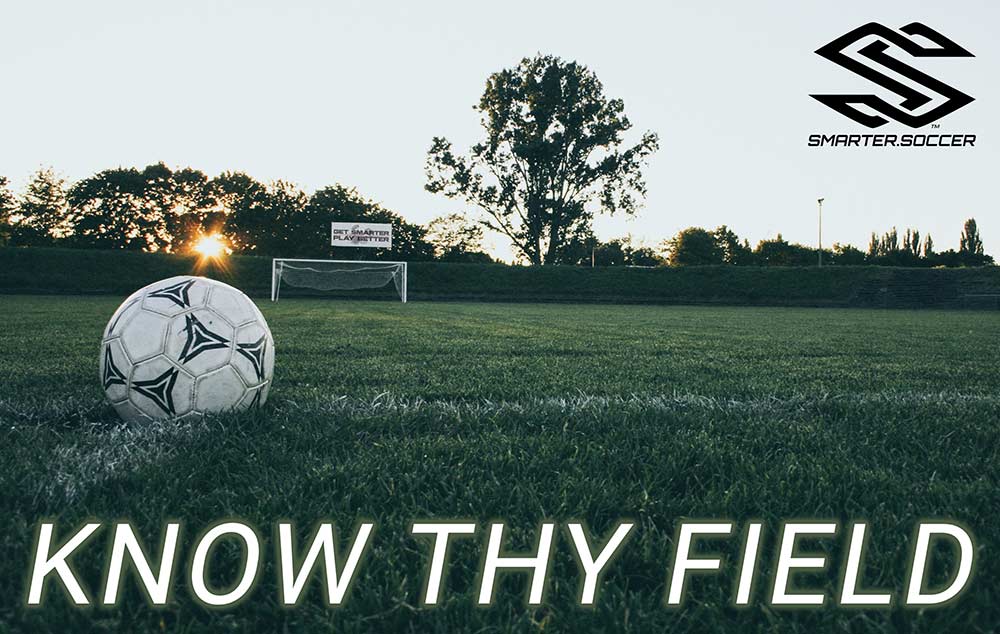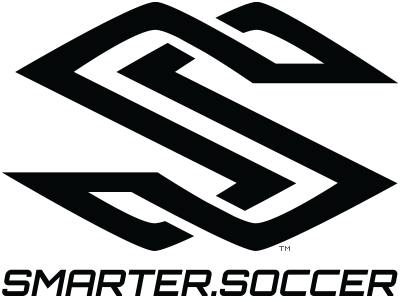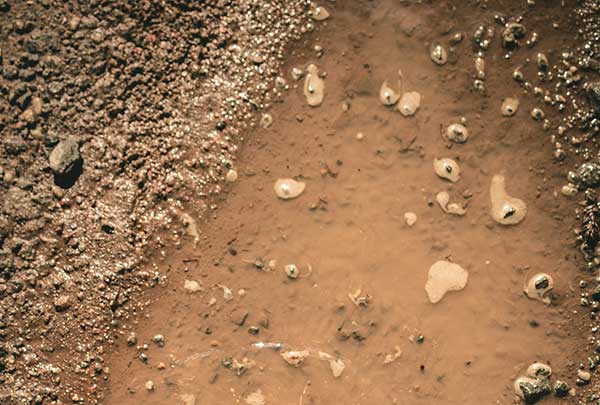KNOW THY FIELD
Smarter soccer players know that the condition of the field has a direct impact on the game. In fact, players who take a moment to look over the field and see how its quality affects play will have an advantage over their opponents who didn’t take that same time and who are oblivious to the conditions when the game starts. The length of the grass, how hard the dirt is, the slope of the pitch, wet spots or dirt patches, and any other issues that will directly impact the game should be noted. Let’s look at a few of these soccer field conditions separately.

➤ Grass Length
The length of the grass is quite important. In dry conditions, longer grass slows the ball down. It becomes “grabby” and more effort has to be put into kicking the ball to make it go the same distance. Shorter grass has the opposite effect. With less friction, the ball tends to skim over the surface, usually going much farther than intended.
This is especially apparent when delivering through balls between defenders. Passes will “take off” and result in going over the endline or simply be gobbled up by the goalie. The “weight” of the pass and directing it at an angle away from the goalie is vital to give your attackers the best chance of collecting the ball and making the most of the opportunity.

➤ Quality Of The Dirt
The state of the soil also has an influence on how the ball travels and more importantly, how it bounces. Softer dirt will absorb and deaden the ball, while hard, “cement-like” dirt will have the opposite effect. Have you ever heard a teammate say: “I can’t believe how high that ball bounced when it went over my head!” That’s because s/he didn’t take the time to evaluate the status of the ground and comprehend beforehand that the ball will have a tendency for big bounces.
Soil with a high moisture content will also slow the ball down. The most obvious being muddy conditions where the ball will “stick,” but wet soil that’s not so obvious to the eye will also arrest movement slowing the ball down.
➔ Listen To The “Soccer Never Stops (And Neither Should You)” podcast!
➤ Slope Of The Field
Are the fields you play on perfectly flat like a table? Never, right? Thus, if you gain an understanding of the inconsistencies, and variations before the match, you can use this to your advantage. The corners of many fields are often where the slants and inclinations are most obvious. Some corner’s drop off, allowing the ball to run off the field faster than expected. Some even have dips and then inclines, so the ball will appear to be ready to go out of play, but then get hung up and stay in bounds.
Better quality fields will often have a hump running lengthwise, meaning they’re higher in the middle and slant down towards the sidelines. They’re designed like this for better drainage in order to eliminate depressions in the field where water can collect and create mud spots. However, this means that balls sent to the sidelines will have a tendency to continue rolling down the bank and go out of bounds quicker than expected. Therefore, you’ll have to adjust how you place “balls into space” and focus on accuracy.
For advanced players, the gradients of the field can be played. The best analogy for this is putting in golf. Golf greens are never level and have all sorts of rises, falls, dips, bumps, tilts and slants to make them more challenging. Pro golfers learn how to “play” these inconsistencies to sink that putt. For example, a winger who dribbles down the side line towards the corner flag knows that the field ramps up towards the endline. A smart ball played past the defender along the endline will actually roll back towards the field to a teammate attacking the front post. However, the winger probably would not have known about the field’s inconsistency if s/he didn’t take time to evaluate the entire field prior to the game.
➤ Rain Or Very Wet Conditions
All things considered, rain probably has the most impact on the field (and overall playing conditions). It affects every aspect of play. We’re going to focus on the field, but smart soccer players know that rain impacts visibility, traction, ball friction and more. On the field, rain can both speed up the ball and slow it down, sometimes one right after another. Moderate rain will cause a flighted ball to “skim” off the grass and rocket forward, making it hard to control as a pass and very difficult to save if you’re a goalie. Smart attackers can use this to their advantage when shooting. By kicking the ball hard just above the ground and targeting it to land just before the goalkeeper, the ball will skip forward, accelerating past his or her body, and into the back of the net.
Players also need to understand how the ball skates forward in the rain. A ball coming to a player in the air will also accelerate forward when it hits the ground. Players need to be aware of what’s going to be happen, prepare their body position and react quickly.
However, while the ball can ricochet off the grass, it can also get bogged down when the rain is heavy and puddles form on the field. Even passes with a lot of force behind them with suddenly stop when they hit a puddle, often with comic effect when opposing players splash away at each other trying to get the ball free.
➤ Snow On The Field
Yes, depending on where you live, you may find yourself playing in the snow. Snow has a similar influence on the field as rain. It can make the field slick with the ball careening and skipping off the surface, or it can be sticky, accumulating on the ball — like when you make a snowman. Either way, while it’s fun to play in, it makes things very, very difficult.

➤ Artificial Turf
While the differences between two different artificial turf fields are less dramatic than grass fields, there are variations that can influence the game. This is especially more noticeable between newer turf technology and older turf fields, especially if they haven’t been well maintained. Both usually use small rubber pellets (recycled car tires) and in rarer cases cork as the field “soil.” New turf fields tend to have longer and slicker plastic “grass blades.” These are less grabby, causing fewer ACL tears (and the dreaded “turf toe”) than first generation fields and have less rebound.
That said, soccer balls will bounce significantly higher on artificial turf fields than grass fields and are much less forgiving of inaccurate passes. Balls tend to roll longer so through balls that penetrate the back line of defense must be angled away from the goalie every time. Well designed turf fields all have the same elevated hump running from goal to goal on the field for drainage (as mentioned above), so passes to the sidelines will not slow down and need to be precise. Wet conditions, like grass, will accelerate ball speed, but puddles will not develop on artificial turf. Older turf fields that aren’t maintained may develop rips and exposed seams that can be very dangerous – be very careful on these surfaces and alert your coach and other players.
➤ Combination Of All The Factors
Often the condition of the field is a combination of several of the facets mentioned above. The perfect example of this is inside the 18 yard box. Even some of the best fields you’ll play on during a season will break down and deteriorate. The first place this happens is inside the penalty area. Between excessive trampling during corner kicks, the goalkeepers constantly walking over the same area, divots from goal kicks and skirmishes in front of goal, this area takes a beating. What ends up happening is the grass dies and it becomes a lumpy mud pit. Worse, the continual stomping actually removes the soil causing a depression – in other words, a bowl with a bottom like the surface of the moon. If you’re a player, especially a goalie, this should cause you serious concern. Craters, clumps, the ball taking strange bounces when it makes contact with bumps, complete loss of traction and other abnormalities can wreak havoc on gameplay. Know how you are going to compensate for these problems before you’re put in that situation to give yourself the best chance for success.
Conclusion
As you can tell from this extensive article (actually much longer than I originally anticipated), a playing surface isn’t so simple as grass and dirt. There is a lot to consider, comprehend and evaluate every time you step on the field to play. Even your home field, can change week to week depending on the circumstances. Instead of wasting your time goofing around with your teammates when you get to the field for a game, take a few moments to look over the entire field. It just might make the difference between you having a good performance and a great one.


Will a playing surface like this have an impact on the game? You bet it will!
A playing surface isn’t so simple as grass and dirt — there is a lot to consider, comprehend and evaluate every time you step on the field to play…
F.01
Know Thy Field
Summary
A playing surface isn’t so simple as grass and dirt. When you get to the field for a game, take a few moments to evaluate the entire field. In close games that come down to the team that makes the less mistakes, it just might make the difference between a win and a loss.
★ Smarter.Soccer Insight: Investigating the field can not only benefit your game play, but by sharing your evaluation with the rest of your teammates, you can give them an advantage as well. A great time to reveal your observations is during the pre-game talk by your coach. When your Coach has concluded his discussion of strategy and assignments, politely ask if you may add something you’ve noticed about the field, and then divulge your assessment. Not only will this inform the entire team about the field at once, but it also makes a great impression on your coach.
